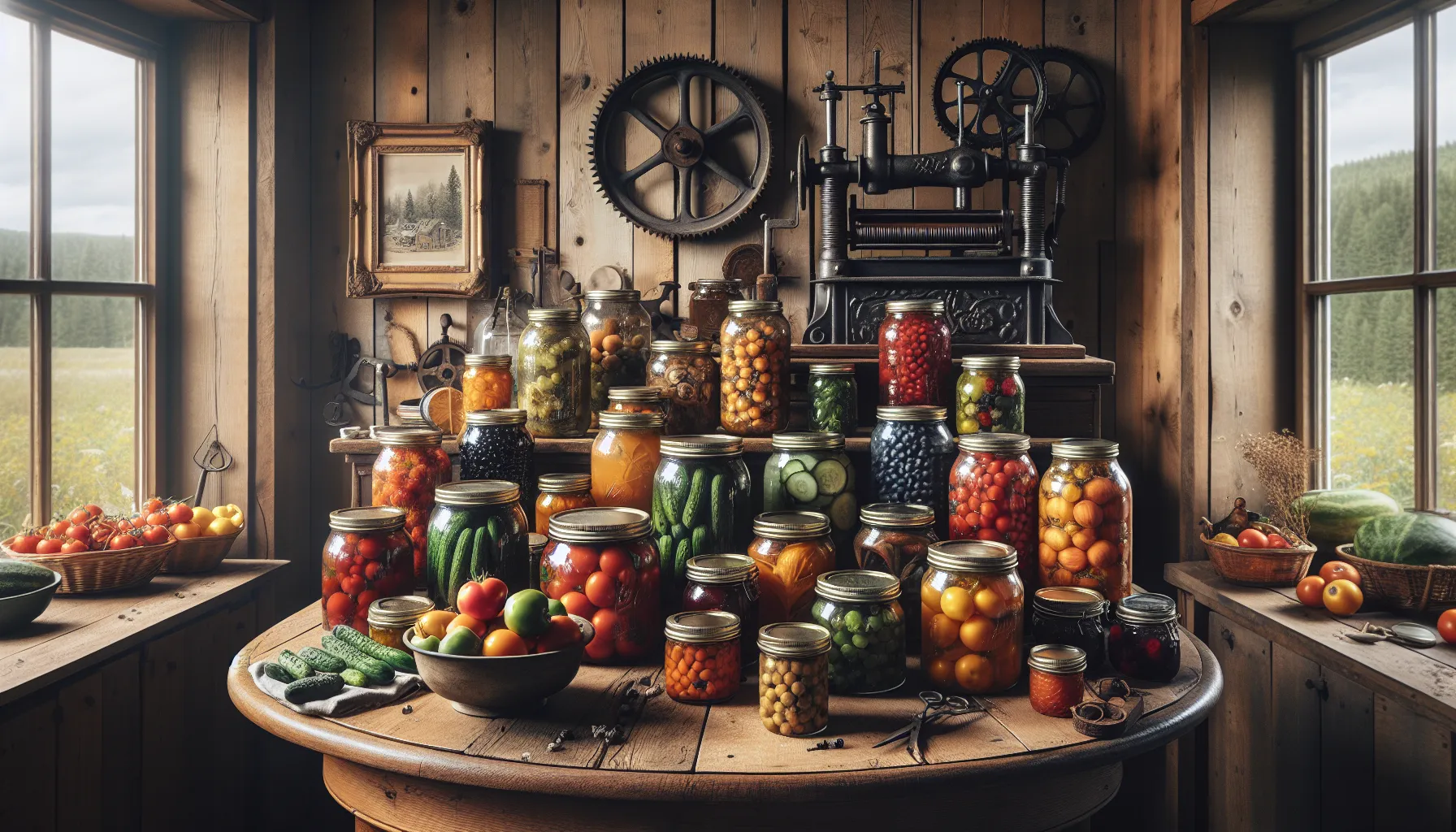What Are Lesser-Known Food Preservation Methods?
Exploring the realm of food preservation, we’ve gathered insights from culinary experts and business founders to unveil fifteen lesser-known methods and their unique advantages. From the simplicity of vacuum packing at home to the nuanced technique of alcohol immersion for flavorful preservation, join us as we delve into the traditional and innovative ways to extend your food’s shelf life.
- Vacuum Packing at Home
- Earthenware for Natural Preservation
- Fermentation Elevates Culinary Experiences
- Sugar Syrup Enhances Fruit Preservation
- Ancient Burial Technique for Food Storage
- Vinegar Pickling for Simple Preservation
- Freeze-Drying for Nutrient Retention
- Edible Coatings Extend Produce Freshness
- Oil Preservation Infuses Flavor
- Dry-Salting Enhances Taste and Shelf Life
- Honey Preservation for Sweetened Snacks
- Dehydration Concentrates Flavors
- High-Pressure Processing Retains Food Quality
- Minimal Processing in Root Cellaring
- Alcohol Immersion for Flavorful Preservation
Vacuum Packing at Home
Vacuum packing is a preservation method that is commonly used commercially but not as frequently at home. It involves removing all the air from the food being preserved, which extends its shelf life significantly, often up to 24 months when stored in the freezer.
While a special machine is typically used for vacuum packing, a simple trick involving a Ziploc bag is submerging it underwater with the bag open to force out any air, then sealing it closed. While it may not yield the same level of air removal as a dedicated vacuum packing machine, it’s a straightforward method that anyone can do at home.
Dehydration is another effective preservation technique that involves removing moisture from the food, thereby inhibiting the growth of bacteria and prolonging its shelf life. However, one drawback of dehydration is that it alters the texture of the food being preserved.
Lastly, pickling with salt or vinegar is a traditional method of preserving food that has been used for centuries. Salting draws out moisture from the food, preventing bacterial growth, while pickling in vinegar or lemon juice, which are high in acidity, also serves as a preservative by creating an environment hostile to bacteria.
These preservation methods not only extend the shelf life of foods but also add unique flavors and textures, making them versatile options for home cooks to utilize to preserve their favorite foods.
 Mark Iwadare
Mark Iwadare
Recipe Creator, Food Expert, Healthy Foods, LowCarbingAsian
Earthenware for Natural Preservation
Nowadays, earthenware food preservation techniques are known and used by a few people. This ancient technique involves storing foods in clay pots or containers. It allows natural air circulation and moisture absorption, keeping the food fresh without the need for refrigeration or artificial preservation. The porous nature of the clay helps to maintain the humidity level and also enhances the flavors of the food as the clay imparts its earthy taste to the stored food.
As a sustainable brand, we promote products made of earthenware. This aligns with our sustainable values and adds a touch of tradition and authenticity to our products. The simplicity and uniqueness of the product make it a valuable technique in the world of food storage with its natural and chemical-free features.
 Swayam Doshi
Swayam Doshi
Co-Founder, Suspire
Fermentation Elevates Culinary Experiences
Fermentation—let’s talk about that. It’s a game-changer in food preservation, not just for your everyday sauerkraut or pickles. This process transforms sugars into acids, gasses, or alcohol, right? In Ukrainian cuisine, it’s traditional—think sauerkraut, pickled veggies, or even fermented dairy products.
But here’s where it gets interesting: There’s a big trend of implementing fermentation in high-end restaurants. I’ve launched more than five restaurants where fermentation is actively used. It brings depth and complexity to dishes. With proper fermentation, you can elevate the food instead of just preserving it.
 Vadim Rachok
Vadim Rachok
Culinary Instructor and Chef, Recipe From Chef
Sugar Syrup Enhances Fruit Preservation
An intriguing preservation method I’ve explored is using sugar syrup for fruits, which involves submerging pieces of fruit in a thick sugar solution. This method not only preserves the fruit by inhibiting microbial growth but also imparts a delightful sweetness, transforming the fruit into a versatile ingredient for desserts, toppings, or standalone treats. The process of creating sugar syrups and understanding the osmotic pressure involved has deepened my appreciation for the scientific aspects of food preservation.
What I particularly enjoy about preserving fruits in sugar syrup is the balance it strikes between maintaining the fruit’s texture and enhancing its natural flavors, all while extending its usability. This method embodies the art and science of food preservation, offering a delightful way to enjoy the essence of fruits long after their peak season.
 Ananvita Bhattacharya
Ananvita Bhattacharya
Owner, WellnessZing
Ancient Burial Technique for Food Storage
Burial used to be a common method for preserving food, especially for root vegetables, tubers, and other plant-based items. Nowadays, it’s considered ancient, and only a few cultures in the world practice this preservation method.
This technique involved placing food underground in cool, dry earth, shielding it from sunlight, moisture, and pests. The natural insulation of the soil helped maintain a consistent temperature, slowing the decay of the food and lengthening its usable life. Although not widely used today, this method demonstrates the ingenuity of early civilizations.
When you bury food, it’s protected from light and air. The ground should be dry and somewhat salty, and you need to dig deep enough to be below where the ground freezes. It’s best to choose a spot that’s dry and sheltered. Fruits and root vegetables were often stored this way.
For example, certain types of cabbage, like Rio Verde or Danish Ballhead, when buried upside down with their roots exposed, were traditionally stored during autumn in colder regions and could be retrieved any time before spring.
 Renato Fernandes
Renato Fernandes
Clinical Nutritionist, Saude Pulso
Vinegar Pickling for Simple Preservation
Vinegar pickling is a preservation method I’ve come to appreciate for its simplicity and effectiveness. Microorganisms that cause food spoilage can’t survive in high-acid environments, making vinegar an excellent preservative. Unlike other methods, it doesn’t require heat or canning processes, which is a huge plus for me.
I’m particularly fond of this technique and make it a point to prepare at least one batch of vinegar pickles each season. It reminds me of the old-fashioned pickle barrels, where preservation was as much about flavor as it was about longevity. Vinegar pickling not only extends the shelf life of foods but also imparts a distinctive, tangy flavor that I really enjoy. It’s a delightful way to preserve a variety of foods while adding a delicious twist to them.
 Rizki Kadir
Rizki Kadir
Automotive Writer & Software Engineer, Our Own Cars
Freeze-Drying for Nutrient Retention
I’m fascinated by the technical side of things, including lesser-known food-preservation methods like freeze-drying. This process removes moisture from food by freezing it and then applying a high vacuum to vaporize the ice without returning it to liquid form. The benefits are substantial: preserved nutritional value, extended shelf life, and lightweight end products. It’s an efficient way to store food for long periods, perfect for both astronauts and adventurers alike.
 Will Li
Will Li
Hardware Engineer, MOKO Technology
Edible Coatings Extend Produce Freshness
One innovative preservation method that has piqued my interest is the use of edible coatings on fruits and vegetables. These coatings, made from natural substances like wax or proteins, create a barrier that helps retain moisture and reduce oxygen exposure, significantly extending shelf life. The beauty of this method lies in its subtlety—the coatings are often tasteless and invisible, preserving the natural look and feel of the produce.
This technique not only reduces food waste but also decreases reliance on plastic packaging, offering an eco-friendly solution to keeping produce fresh. I’m fascinated by the potential of edible coatings to revolutionize the way we store and consume fresh produce, making it a promising area for further exploration and application in food preservation.
 David Ciccarelli
David Ciccarelli
CEO, Lake
Oil Preservation Infuses Flavor
A preservation method that intrigues me and is often overlooked is oil preservation. This technique involves submerging ingredients, typically herbs, spices, or vegetables, in oil to create an anaerobic environment that slows down the growth of bacteria.
One significant benefit of preserving food in oil is the infusion of flavors, creating gourmet oils that are delicious and versatile in cooking. Another advantage is the method’s simplicity and the ability to use various oils, such as olive or sunflower, to complement the preserved item’s flavor.
Oil preservation not only extends the shelf life of fresh produce but also adds a depth of flavor to dishes. Plus, it’s a beautiful way to store and display ingredients like garlic, chili peppers, or rosemary, turning them into both a pantry staple and a kitchen decoration.
 Phil Strazzulla
Phil Strazzulla
Founder, SelectSoftware Reviews
Dry-Salting Enhances Taste and Shelf Life
A unique method I’ve been fascinated with is dry-salting, which is different from brining or pickling. This technique involves covering food, particularly vegetables or meats, with salt to draw out moisture. The benefits of dry-salting are manifold: it not only preserves food by inhibiting bacterial growth but also intensifies the food’s flavor, making it a fantastic method for enhancing taste profiles.
Furthermore, dry-salting requires no electricity, making it an excellent option for sustainable living or in situations where refrigeration isn’t feasible. I’ve found that foods preserved through dry-salting, like salt-cured meats or salted vegetables, add a robust flavor to dishes that is both unique and delightful.
 Tony Mariotti
Tony Mariotti
CEO, RubyHome
Honey Preservation for Sweetened Snacks
Preserving food using honey is an ancient method that’s less common today but offers remarkable benefits. Known for its natural antibacterial properties, honey acts as a barrier to moisture, allowing it to preserve fruits, nuts, and even meats in a delicious, sweet form.
The benefits of using honey as a preservation medium include an extended shelf life, enhanced flavors, and the added health benefits of honey itself, which is rich in antioxidants and can help with digestion. I’ve experimented with honey preservation to create unique, sweetened fruits and nuts that serve as both a snack and a natural sweetener.
This method stands out for its simplicity and the rich, complex flavors it imparts to preserved foods, making it a delightful way to enjoy the bounty of the seasons year-round.
 Mika Kujapelto
Mika Kujapelto
Managing Director, Casino Professor
Dehydration Concentrates Flavors
A lesser-known food preservation method is dehydration. Dehydration involves removing moisture from food, which inhibits the growth of microorganisms and slows down spoilage. The benefits of dehydration include an extended shelf life, reduced weight and volume, and preservation of nutrients.
By removing water, dehydration concentrates the flavors of the food, resulting in intensified taste profiles. Dehydrated foods are lightweight, making them convenient for storage and transportation. They also retain many essential vitamins and minerals, providing a nutritious option for long-term preservation. Dehydration can be achieved through air-drying, sun-drying, or specialized dehydrators. It’s a simple and effective technique that allows you to enjoy preserved foods even when fresh options are not readily available.
 Adrian Pereira
Adrian Pereira
Co-Founder, Eco Pea Co.
High-Pressure Processing Retains Food Quality
Given my background in food packaging equipment and processing machinery with C-FAB LLC, I’ve had the opportunity to explore various innovative technologies enhancing food preservation. One lesser-known method that stands out is High-Pressure Processing (HPP). This method involves the application of high pressure (about 600 MPa) to food products, which inactivates pathogens and spoilage organisms while preserving food quality and extending shelf life.
What makes HPP particularly beneficial is that it allows for the preservation of foods without the use of high temperatures, retaining the nutritional and sensory properties of food better than traditional thermal methods. This is because the pressure is applied uniformly, which does not cause significant changes to the food’s structure. We’ve implemented HPP for clients seeking to improve the shelf life and quality of juices, seafood, and ready-to-eat meals, and the feedback has been overwhelmingly positive.
Case studies from our work at C-FAB have demonstrated not only an extended shelf life for products treated with HPP but also an enhanced safety profile without the need for preservatives. One example is a juice company that saw its products’ shelf life increase from a few days to several weeks, significantly reducing waste and improving marketability. This kind of innovation aligns with our mission to provide sustainable solutions for the food industry while maintaining the highest quality standards. As food safety and quality continue to be paramount, technologies like HPP are paving the way for a new era of food preservation.
 Todd Cleppe
Todd Cleppe
Executive Engineer and Sales, C-FAB LLC
Minimal Processing in Root Cellaring
A lesser-known food preservation method I’ve found useful is minimal processing, involving techniques like root cellaring and cool or room-temperature storage. This method is incredibly easy to implement at home. It primarily uses spaces like an unheated pantry, porch, or root cellar, which could be an unheated basement space, crawl space, or even in-ground clamps.
The concept of a “root cellar” is particularly interesting. It’s essentially about storing food in cool, damp conditions naturally found in these areas. This method is great for preserving a variety of produce including potatoes, carrots, cabbage, beets, apples, onions, and garlic. It’s also suitable for crops like shell beans, dry corn, pumpkins, and squash, which require minimal processing for storage.
The beauty of this technique lies in its simplicity and cost-effectiveness. It utilizes the natural environment to keep food fresh without the need for electricity or fancy equipment, making it both practical and sustainable.
 Danilo Miranda
Danilo Miranda
Managing Director, Presenteverso
Alcohol Immersion for Flavorful Preservation
Immersion in alcohol is a unique food preservation method I’ve experimented with. Similar to the way salt and sugar work, alcohol draws moisture out of food, preventing the growth of microbes. By submerging small quantities of food in a hard liquor of choice, the food can be preserved for an impressively long period.
One crucial aspect I’ve learned is the importance of the alcohol-to-food ratio. It’s vital not to overcrowd the alcohol with too much food, as there’s only so much water the alcohol can absorb. This method not only ensures long-term preservation but also infuses the food with unique flavors, depending on the type of alcohol used. It’s an interesting technique that combines preservation with a touch of culinary creativity, perfect for those looking to experiment with different flavors and preservation methods.
 James Mcnally
James Mcnally
Managing Director, SDVH [Self Drive Vehicle Hire]
Submit Your Answer
Would you like to submit an alternate answer to the question, “What is a lesser-known food preservation method and its benefits?”
